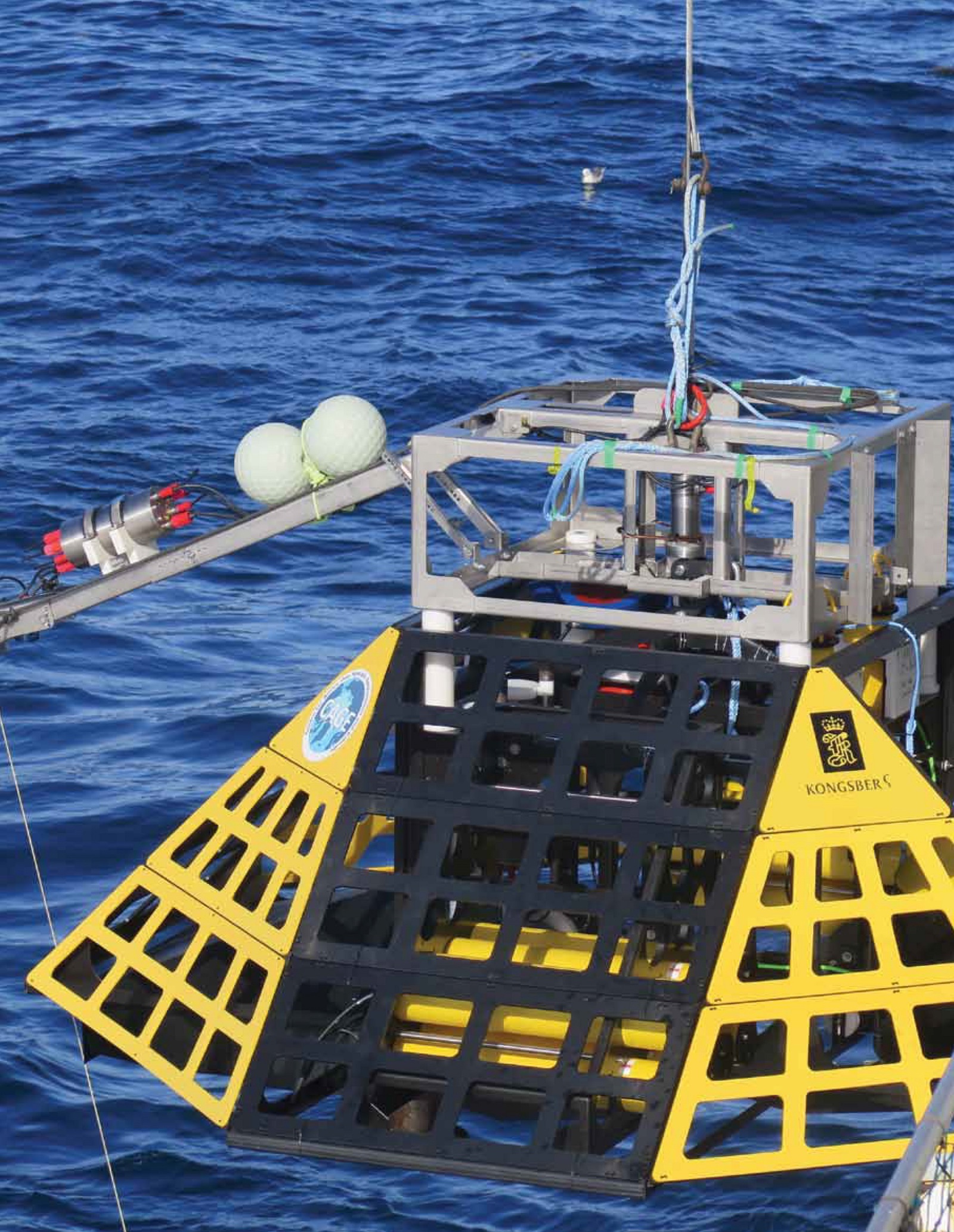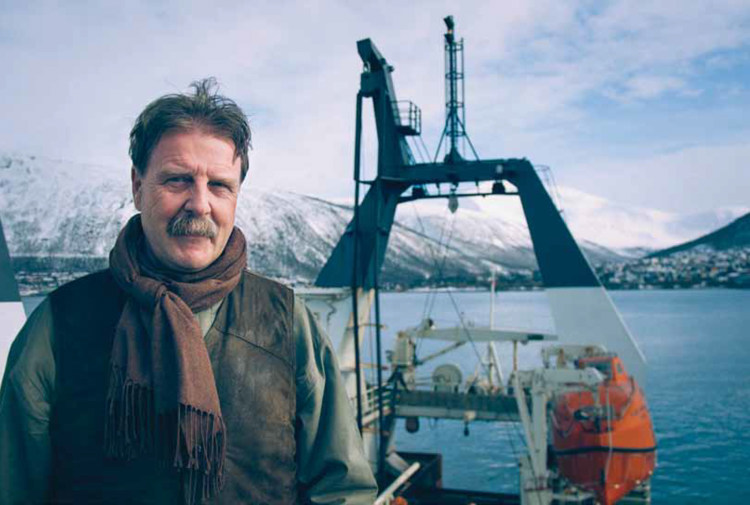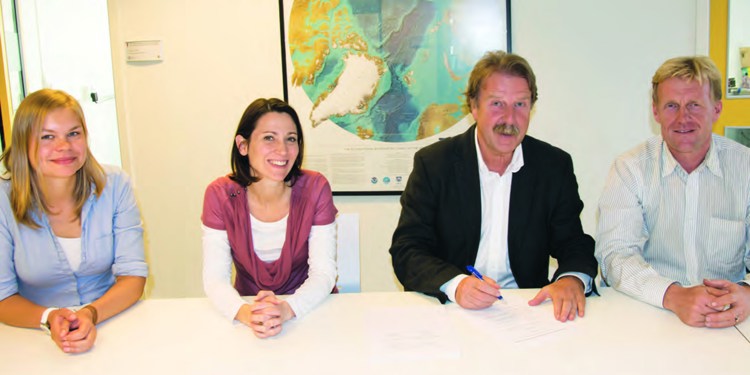
There are three things that are fundamental for the future of research: creativity, ideas and technology. The CAGE Centre for Arctic Gas Hydrate, Environment and Climate leads the way in all three, as it sets out to uncover the secrets of ‘the ice that burns’.
-
Text:Kongsberg Maritime Communication
-
Gunvor Hatling MidtbøVice President, Communications
At the northernmost university in the world, surrounded by nothing but ice-capped mountains and vast stretches of ocean, sits a research centre that leads the way within its field. The CAGE Centre for Arctic Gas Hydrate, Environment and Climate is located in the city of Tromsø, the Arctic capital. Its presence here is anything but coincidence. Tromsø’s UiT is a renowned institution, with an excellent Geology department, while the Arctic is a natural home for studying gas hydrates, which are common in the region’s icy waters.
Jürgen Mienert, director of the CAGE centre, explains: “Gas exists naturally in the ocean floor, and is stored in the form of hydrates in continental margins worldwide, where there is high pressure and low temperature. Their prevalence is therefore particularly high in the Arctic region, and Tromsø offers the perfect starting point for this type of research.”
DUAL MEANING, SINGULAR PURPOSE
The CAGE acronym has two meanings. In addition to being an abbreviated name for the centre itself, it also refers to how methane molecules form a network of water molecules in the shape of a cage. These ice-like crystalline solids of water molecules encaging gas molecules, are often referred to as ‘the ice that burns’. This is because when heated, the water drips while the gas hydrates burn.
This cage of molecules is what Jürgen Mienert and his team study in order to understand how methane gas is released from the sea floor, how it is transferred into the atmosphere, and how this impacts upon our environment.
“Our goal is to discover the connection between the large quantity of gas hydrates in the Arctic region and climate change. Methane is many times more aggressive than CO2, and is therefore considered an environmental hazard. We want to understand the dynamics of the gas hydrate system, both when it comes to quantity and its reactions to pressure and temperature. Our research therefore covers both subsea reservoirs on the sea floor and in the ocean within Arctic regions,” Mienert says.

RESOURCE AND HAZARD
While it has been established that methane released from hydrates will accelerate climate change, because it is a major greenhouse gas, gas hydrates have another, perhaps less well-known function – as a potential unconventional energy resource for the future. This is another field of research that should not be confused with studies of its environmental impact.
“While other fields of study concentrate on the possibility of using methane gas as an energy source, CAGE is unique in that it focuses solely on the environmental and climate aspect of gas hydrates. This is the first time that research has been conducted on the entire methane emission system, from the seabed and into the atmosphere. We have discovered that bacteria eats the methane gas, which is something that can stop its release into the atmosphere,” explains Mienert.
NORWEGIAN CENTRE OF EXCELLENCE
CAGE is staffed by a team of 50 scientists, conducting cross-disciplinary research in a variety of projects. The importance of this field of research is so significant that the centre has been granted status as a Norwegian Centre of Excellence. Few research teams in Norway can boast this prestigious title. Out of the 139 research groups that submitted applications in 2012, only 29 made it through to a shortlisted decision round, with just 13 passing a final test based on both the scientific merit of ongoing and planned research activities and the quality of their personnel. Other factors that were assessed included the added value of creating a centre, national and international cooperation, and environmental impact. The CAGE centre has it all.
“Our researchers are the best in the country within their respective fields,” Mienert states. “We also collaborate closely with other research institutions in Europe, Russia and North America, something which contributes to making our centre and research visible both nationally and internationally.”
“The industry can develop systems that are useful for research, and our research may in turn be interesting for industry, so this is a win-win situation.”

THE IMPORTANCE OF TECHNOLOGY
As a Norwegian Centre of Excellence, CAGE receives 140 MNOK of support from the Research Council of Norway over a period of 10 years. A part of this award covers the acquisition of the technology that is necessary to complete the project.
“Research without technology will not function in the future. In my opinion, the three most important criteria for conducting research are: ideas, creativity and technology. There should be more conversations with relevant industries to establish which types of technology we need. In this way, research communities can be a driver for technological development. The industry can develop systems that are useful for research, and our research may in turn be interesting for industry, so this is a win-win situation,” Mienert notes, while also underlining that the CAGE centre is engaged in basic research, which is not industry specific.
“Our goal is not to serve certain industries, but to conduct basic research within our field. This is not to say that our findings can’t be useful in some ways. For example, it is useful for certain parts of industry to know the location of gas hydrates,” he says. Ocean observatories
In October 2014, CAGE signed a contract with Kongsberg Maritime for the delivery of two ocean observatories. The observatories are unique, constructed especially for this project, and contain a range of sensors to serve the purpose of the research team. They will be paramount to conducting this innovative type of research.
“The observatories from KONGSBERG will be used by the team researching water columns and how gas hydrate emissions change the chemistry of the sea,” Mienert explains, before adding: “More specifically, we want to find out how much methane is released and how this impacts upon the atmosphere. In order to understand this dynamic, we need to stay in the same place for a period of several months, maybe even years. The ocean observatories will stay on the sea floor for a period of 12 months collecting data. This data can be sent to the surface while they undertake their on-going tasks.”
Using the university’s own research vessel, Helmer Hansen, the CAGE researchers go on month long expeditions exploring areas from the Kara Sea to the Barents Sea, which form part of the Arctic waters to the north of Norway and Siberia. These seas provide optimal conditions.
“In addition to providing the right temperature for containing methane gas, the Arctic areas are interesting with regards to ocean currents and depths. These areas contain large stretches of gas emissions that are interesting for our research,” says Mienert. Unique constructions
The observatories were successfully tested in March 2015, before being deployed off the coast of Svalbard in June 2015. They are self-contained, advanced autonomous sensor systems boasting a range of integrated sensors. During their year-long stay on the sea floor, the observatories will be powered by battery packages, capable of wirelessly keeping contact with the surface through Kongsberg Maritime developed acoustic communication technology.
“The ocean observatories from KONGSBERG consist of a range of different sensors, measuring such factors as water mass, oxygen, CO2, pH, current bubbles in the water columns, climate on the sea floor and even sound. These observatories are unique and have never been produced before. We needed a partner that was at the vanguard of technological developments, and KONGSBERG provided the right set of expertise with its extensive knowledge of the maritime industry,” Mienert comments.
FUTURE OPTIMISM
The CAGE research project is still in its early stages, and it may take years of research within several different disciplines to achieve results. While environmental research often paints a dark picture of our future and potential hazards, Mienert is optimistic. “We need to place our research in a historical perspective, and the world has already lived through several environmental catastrophes,” he says, concluding: “The oceans contain vast, unused possibilities, and with the increase in the world population, we might need to look to them for resources. Our research will hopefully be a resource for the future, and we might get a little closer to understanding the full picture of how environmental factors function together.”